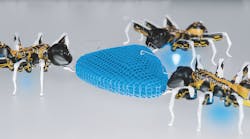Because the industrial communications landscape evolved in relative isolation from the greater world of IT networking, it’s populated with a variety of “point-in-time” solutions designed to solve problems specific to industrial environments. In their earliest iterations, device-level and plant-floor communication links often relied on proprietary technology from a single supplier to provide sufficient levels of reliability and determinism. But over the years, these protocols have become increasingly standard and open, allowing diverse ecosystems of system and device suppliers to work together in plants and factories around the world.
Ethernet is increasingly a common denominator, and underpins the latest generation of the “industrial Ethernet” solutions that prevail today. Profibus morphed into Profinet. EtherNet/IP has its roots in ControlNet. CC-Link became CC-Link IE (for industrial Ethernet). Meanwhile, Foundation fieldbus over “high-speed” Ethernet becomes Foundation HSE, and HART becomes HART IP. Ethernet-based EtherCAT and Powerlink also are central players in the machine -automation space, and even Modbus, a 35-year-old serial communication protocol, has new life today as Modbus TCP.
Initially focused on simply getting data from one place to another, some of today’s industrial communication and integration standards also have become increasingly rich, with added layers of security, diagnostics and semantics. OPC UA, in particular, has been embraced by many suppliers on the OT side of the divide, and IT-side providers are kicking its tires as well. (See sidebar)
Few existing industrial facilities have a uniformly current network infrastructure, and fewer yet can afford to rip and replace everything they have. As a result, the integration of plant-floor devices and systems with today’s brave new world of the industrial IoT (IIoT) is rarely addressable with a one-size-fits-all solution.
Assessment is job one
The first step in preparing for the IIoT is documenting the network that you have, says Mark Wylie, global vertical market manager, industrial IT, for Belden, a specialist in networking infrastructure. “Many industrial sites have networks that evolved over time: they added Ethernet here, and a Wi-Fi access point there, but they don’t have a properly documented, segmented network.” Some plants turn a blind eye to these issues, hoping instead for “security by obscurity,” Wylie notes. “They rely on the fact that the network is hidden. But if the plant network goes down, there’s no way to know where the issues are.”
“The IIoT is just accelerating the amount of data on these networks,” Wylie adds. “You can get ready to play in the IIoT by first documenting and preparing your infrastructure.”
Rockwell Automation also stresses the importance of assessment when undertaking to build a converged OT/IT network that will enable the realization of what the company calls “The Connected Enterprise.” The assessment stage of Rockwell’s Connected Enterprise Maturity Model involves a thorough evaluation of all aspects of an organization’s OT/IT network, including IT hardware and software, control systems and devices that feed and receive data and networks as well as the policies, people and processes involved in managing this framework—if a recognizable framework even exists.
“We assess the readiness of an industrial company to change its processes and information architecture to leverage timelier and more accurate information that is available in the enterprise today,” says Keith Nosbusch, Rockwell Automation chairman and CEO. “We often find that less effective legacy processes are in place, and that those processes and work flows have not been designed to take advantage of the OT/IT convergence and the significant benefits available from the connected enterprise. We then help industrial companies establish a strategy that systematically, sequentially, and securely integrates the technologies, processes, and people.”
Once gaps and weaknesses in the current OT/IT network and support structures have been identified, Rockwell Automation then works with its customers to develop a remediation and upgrade plan with an eye to long-term plans and new technologies. A secure and converged OT/IT network, in turn, lays the groundwork for an organization to inventory and begin to leverage the “working data capital” it now has access to, and apply analytics to improve operations internally and collaborate more productively with suppliers and customers.
Developed by engineers at Festo AG, these artificial ants demonstrate how self-organizing individual components can communicate with each other and solve complex tasks as a networked overall system. The BionicANTs are intended to demonstrate how future production systems can be based on increasingly intelligent components that flexibly adapt to different production scenarios.
Bridging old and new
From a practical perspective, bridging the IT/OT divide and securing the resultant architecture will likely require some new network infrastructure as well as a combination of gateways, protocol converters and firewalls where it makes sense to keep older networks in place. “Many older pieces of equipment still communicate serially, and until they are made more intelligent, IIoT will be on the backburner,” says Eddie Lee, director of global industry marketing, Moxa. “We’re focused on serial-to-network converters, device servers—getting all those legacy -devices onto the IIoT playing field.”
But be mindful that not all data need be collected, notes Steve Jennis, senior vice president of corporate development, IIoT platform services and software, PrismTech. “If data can stay within a subsystem, for God’s sake leave it there. Only pull out what can add value.”
For facilities with older wiring that’s not quite up to Cat 5 cabling standards, PCN Technology offers a unique way for users to run industrial Ethernet protocols on older wiring. In effect, their technology establishes a “virtual” Cat 5 network on existing standard, specialty and proprietary cabling. “The main question we address is this: When you have a mix of legacy serial networks with proprietary cabling, how do you move to industrial Ethernet?” says Daniel Drolet, executive vice president of marketing and business development. “Companies come to us when they’re trying to solve an issue on a particular line, not retrofit an entire plant,” Drolet says. “We can help them reduce risk and costs while they prepare to bring forward their wiring infrastructure on their own terms.”
Wireless, too, has a role to play in in-plant IIoT applications, both by enabling the connectivity of low-power mesh networks of sensors that are much easier and less expensive to deploy than their wired counterparts, and by enabling connectivity with smartphones, tablets and other productivity-enhancing tools for workers on the go.
Some industrial facilities are successfully leveraging cellular wireless technology to satisfy both types of in-plant connectivity needs, notes Todd Landry, corporate vice president, product and market strategy, JMA Wireless. JMA specializes in bringing dedicated cellular data services to industrial environments, ensuring not only adequate coverage but also sufficient bandwidth.
No matter what underlying wireless technologies are used, many organizations underestimate the complexities of radio frequency (RF) behavior in industrial environments, Landry says. “A lack of planning is the biggest downfall.” For example, adding more Wi-Fi access points can actually degrade network performance, as they start interfering with one another. “Users should embrace heterogeneous RF planning, and realize that multiple wireless network technologies often work better together than either alone.”
A flatter architecture
As open Ethernet-based standards continue to take on an ever larger share of in-plant communication tasks, a flatter automation architecture will emerge, predicts Stefan Schönegger, international marketing manager for B&R Automation. At base, B&R is committed to Ethernet Powerlink, its particular variant of industrial Ethernet. “But up a level there’s a heterogeneous environment where OPC UA can help. It’ll be straight from Powerlink to OPC UA. We believe the architecture becomes simpler,” Schönegger says.
“We believe the control and manufacturing execution system (MES) levels will be a bit less important in the future,” agrees Armin Pühringer, business development manager for Hilscher, a specialist in data connectivity solutions across many of the protocols used in industry. This flatter architecture will “allow for more decentralized control and self-organized intelligence at the device level.”
OPC UA seeks to unite OT, IT applications
OPC UA is different from most of the communication standards that have developed in the industrial world. Operating at a higher, semantic level than lower-level fieldbus protocols, OPC UA facilitates the meaningful exchange of data among software applications, regardless of underlying platform or protocol. As such, OPC UA has gained significant traction among OT suppliers, and more and more devices shipped today come equipped to communicate directly via OPC UA over standard protocols.
At April’s Hannover Fair in Germany, KUKA demonstrated its iiwa (for intelligent industrial work assistant) collaborative robot integrated via OPC UA with the Microsoft Azure cloud. Workers monitored order progress and made corrections in real-time through Windows tablets.
“UA changed OPC’s historically Microsoft Windows-centric orientation,” explains Tony Paine, CEO of Kepware Technologies, a provider of communication and interoperability solutions for the automation industry. “OPC is now independent of hardware platform, and the current focus of the OPC community is: How can we take data and make it available to new types of applications?”
This clearly includes promoting OPC UA’s use and suitability for the broader IIoT. One way to do that is to deploy it over multiple, alternative protocols such as those used for cloud-side IoT integration. Another is to involve players from the IT side of the industry in the continuing development of the OPC standards. Yet another is to make the standard more open and available to IT-oriented solution developers. The OPC Foundation is taking steps in all three directions.
At April’s Hanover Messe trade fair, for example, KUKA demonstrated OPC UA-based integration between one of its Intelligent Industrial Work Assistant (iiwa) robots and an application running on Microsoft’s Azure cloud-services platform (image). “Our goal with OPC UA is to allow communication over TCP, UDP and any other protocols that industry wants,” notes Stefan Hoppe, president the OPC Foundation-Europe and product manager for Beckhoff Automation. The Foundation also has formed a committee to examine the IEEE’s work toward a Time Sensitive Networking (TSN) standard, which is intended to add new deterministic capabilities to Ethernet, according to Hoppe.
The naming of SAP’s Veronika Schmid-Lutz to the OPC Foundation board, too, is indicative of this new direction. “We wanted to send a very clear signal,” Hoppe says. As does the Foundation’s announced intent to release OPC UA as a fully open industry standard (no membership required), such as developers from the IT world expect. “OPC is not viewed as open today,” adds Kepware’s Paine. “But that’s changing.”






